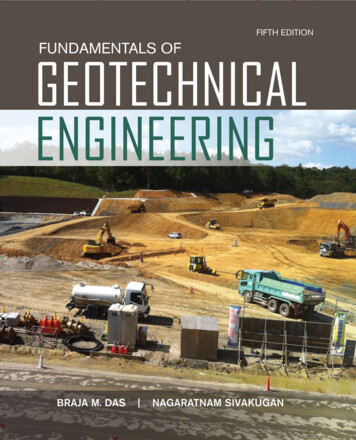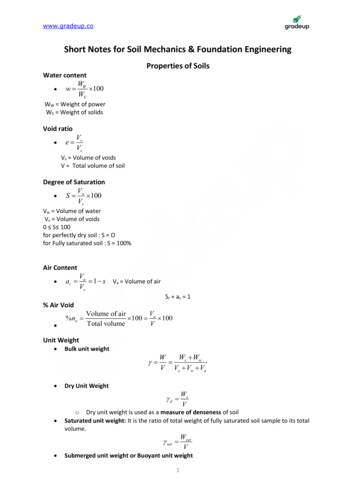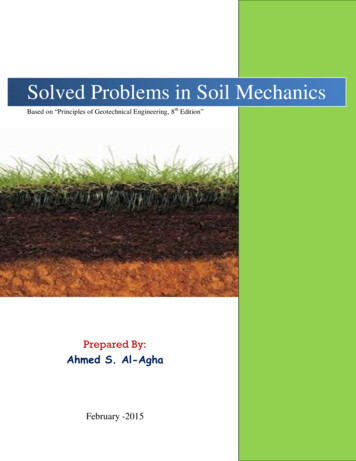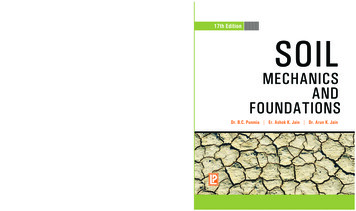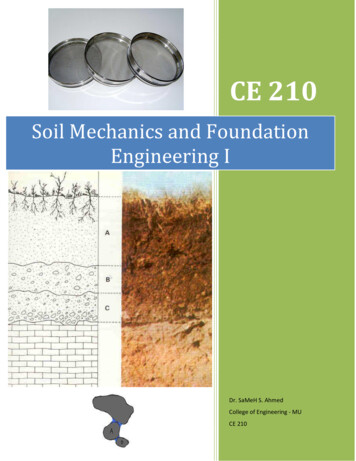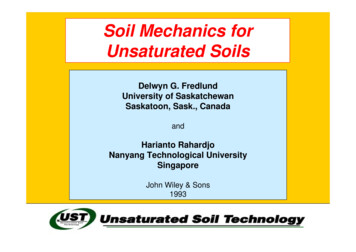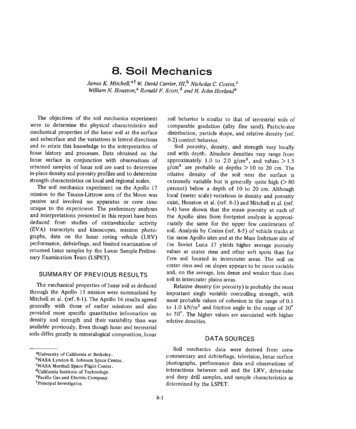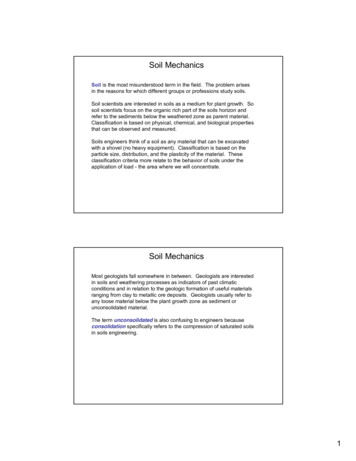
Transcription
Soil MechanicsSoil is the most misunderstood term in the field. The problem arisesin the reasons for which different groups or professions study soils.Soil scientists are interested in soils as a medium for plant growth. Sosoil scientists focus on the organic rich part of the soils horizon andrefer to the sediments below the weathered zone as parent material.Classification is based on physical, chemical, and biological propertiesthat can be observed and measured.Soils engineers think of a soil as any material that can be excavatedwith a shovel (no heavy equipment). Classification is based on theparticle size, distribution, and the plasticity of the material. Theseclassification criteria more relate to the behavior of soils under theapplication of load - the area where we will concentrate.Soil MechanicsMost geologists fall somewhere in between. Geologists are interestedin soils and weathering processes as indicators of past climaticconditions and in relation to the geologic formation of useful materialsranging from clay to metallic ore deposits. Geologists usually refer toany loose material below the plant growth zone as sediment orunconsolidated material.The term unconsolidated is also confusing to engineers becauseconsolidation specifically refers to the compression of saturated soilsin soils engineering.1
Soil MechanicsEngineering Properties of SoilThe engineering approach to the study of soil focuses on thecharacteristics of soils as construction materials and the suitability ofsoils to withstand the load applied by structures of various types.Weight-Volume RelationshipEarth materials are three-phase systems. In most applications, thephases include solid particles, water, and air. Water and air occupyvoids between the solid particles. For soils in particular, the physicalrelationship between these phases must be examined. A mass of soilcan be conveniently represented as a block diagram, with each phaseshown as a separate block.Soil MechanicsThe relationship between weight and volume can be expressed as:Wm VmGmγwwhere:Wm is the weight of the material (solid, liquid or gas),Vm is the volume of the material,Gm is the specific gravity of the material (weight of a materialrelative to the weight of an equal volume of water dimensionless) andγw is the unit weight of water (mass * gravity - 62.4 lb/ft3 ,1.0 g/cm3 and 9800 N/m3).AlsoWs VsGsγwand the weight of water is:Ww VwGwγw Vwγw(since the specific gravity of water is 1)2
Soil MechanicsWhen dealing with a soil sample from the field that contains bothwater and soil particles, the unit weight can be expressed both withand without the water contained in the soil. The unit wet weight isgiven by:γwet WT/ VT(total weight over total volume in kg/m3, g/cm3 or lbs/ft3)and is determined by weighing a known volume of soil withoutallowing any drainage or evaporation of water from the voids.Alternatively, the unit dry weight is expressed as:γdry Ws / VT(weight of solids over total volume)Unit dry weight is determined by oven drying a known volume of soil.The resulting weight will be the weight of solids (Ws). Both unit wetand dry weights are expressed in pcf or g/cm3.Soil MechanicsThe weight of water in a soil sample that was oven dried is thedifference between the weight before drying and the weight of solidsmeasured after drying.The water content (w) of a soil, which is expressed as a decimal orpercent, is defined as:w W w / W s x 100%where - w – water contentW w – weight of waterWs – weight of solids3
Soil MechanicsRelationships between volumes of soil and voids are described by thevoid ratio (e) and porosity (n).The void ratio is the ratio of the volume of voids to the volume ofsolids: (expressed as a decimal):e Vv / Vswhereas the porosity is the ratio of void volume to total volume:(expressed as a percent)n Vv / VT x 100%These terms are related and it is possible to show thate n/1-nThe term degree of saturation (S) relates the volume of water in thevoid space to total void volume:S Vw / Vv x 100%problemSoil MechanicsPoisson’s RatioV E1 / EwhereE1 lateral strainE is axial strainASSUMING there is no change in volumeE1 D / D1H1H2D1E H / H1D24
Soil MechanicsIndex Properties and ClassificationParticles size and distribution, type of particle, density and watercontent relate to the shear strength, compressibility, and other aspectsof soil behavior. These index properties are used to form engineeringclassifications of soil and can be measured by simple lab or field testscalled classification tests.Index Properties of SoilsSoil typeIndex PropertyCoarse-grained(cohesionless)Particle-size distributionShape of particleClay contentIn-place densityRelative densityFine-grained(cohesive)ConsistencyWater contentAtterberg limitsType and amount of claySensitivitySoil MechanicsIndex Properties and ClassificationAn important division of soils for engineering purposes is theseparation of coarse-grained, or cohesionless soils, from fine-grained,or cohesive soils. Cohesive soils, which contain silt and clay, behavemuch differently from cohesionless materials.The term cohesion refers to the attractive forces between individualclay particles in a soils.The index properties that apply to cohesionless soils refer to the sizeand distribution of particles in the soil. These characteristics areevaluated by mechanical analysis, a laboratory procedure thatconsists of passing the soil through a set of sieves with successivelysmaller openings. The size of the sieve openings determines the sizeof the particles that can pass through them. After the test, theparticles retained on each sieve are converted to a weight percentageof the total and then plotted against particle diameter as determinedby the known sieve opening size. The result is a grain-sizedistribution curve.5
Soil MechanicsIndex Properties and ClassificationThe shape of the grain-size distribution curve is a very important soilcharacteristic. A curve that covers several log cycles of the graphcontains a variety of particle sizes. This type of soil would be calledwell-graded.The opposite type of soil, composed of a very narrow rangeof particle sizes, would be classified as poorly graded.Soil MechanicsIndex Properties and ClassificationFor a soil to be truly described as well-graded, it must also meet certain criteria.The coefficient of uniformity, Cu, must be greater than 4 for gravel, andgreater than 6 for sand, and the coefficient of curvature, Cc, must bebetween 1 and 3.The coefficient of uniformity is calculated from the graph by the followingformulas:Cu D60 / D10whereD60 is the particle-size diameter for which 60 percent of thesample was finer, and,D10 is the particle-size diameter for which 10 percent of thesample was finer.These same diameters are used in computing the coefficient of curvatureaccording to the formula:Cc (D30)2 / (D10 * D60)grain-size distribution curve.6
Soil MechanicsIndex Properties and ClassificationThese terms can be easily confused with the term sorting, the geologicaldesignation for grain-size distribution.Geologists would refer to a poorly graded soil with a narrow range of sizes aswell sorted.The opposite, a well graded soil, would be considered poorly sorted bygeologists.To determine whether a material is sand or gravel note where the D50 valuelies on the grain-size distribution curve and extrapolate straight down to thegrain-size. If the D50 value is less than 5 mm in diameter it is considered to besand (fine, medium or coarse) and if the D50 value is greater than 5 mm thanthe material is considered to be a gravel.Soil MechanicsIndex Properties and ClassificationThe other index properties describing cohesionless soils include particleshape, in-place density, and relative density (Dr). These properties arerelated because particle shape influences how closely particles can be packedtogether. The in-place density refers to the actual density of the soil at itsparticular depth in the field. It is measured by weighing an oven-dried sampletaken from a known volume. The relative density is the ratio of the actualdensity to the maximum possible density of the soil. It is expressed in terms ofvoid ratio:void ratio in loosevoid ratio in natural setting,DR (emax - e0)/( emax - emin) * 100%whereemax is the void ratio of the soil in its loosest condition,e0 is the void ratio in its natural condition, andemin is the void ratio in its densest condition.Both emax and emin can be measured in lab tests. Relative density is a goodindication of possible increases in density, or compaction, that may occur ifload is applied to the soil.7
Soil MechanicsIndex Properties and ClassificationThe index properties of fine-grained, or cohesive, soils are somewhat morecomplicated than the index properties of cohesionless soils because of theinfluence of clay minerals. The type and amount of clay minerals are,therefore, very significant.Clay size versus Clay mineralThe concept of clay size versus clay mineral has plagued soils workers formany years. Clay minerals are fine-sized platy silicates that have the propertyof plasticity, that is, they can be rolled into a thin thread which adheres togetherat low moisture levels.Clay size, by contrast, is a small particle size designation that does not alwaysensure that its constituents will be plastic. In actual fact, some fine-sized quartzand feldspar grains can occur in the range of 0.005 mm and it is these nonplastic materials that complicate the problem. However, very few feldspar andquartz grains occur at 0.002 mm and below, so by placing the clay boundary atthis lower value, the clay size and clay mineral designations coincide quite well.Soil MechanicsIndex Properties and ClassificationWith respect to engineering behavior, consistency is the most importantcharacteristics of cohesive soils. It refers to the strength and resistance topenetration of the soil in its in-place condition.Consistency is determined by the arrangement of soil particles, particularlyclay particles, in the soil, which is called the soil’s fabric. Although many typesof fabric are possible, soils in which edge-to-face contact of clay particles existsor soils which have flocculated fabrics, are much stronger than soils whichhave the parallel arrangement of particles found in dispersed fabrics.Flocculated fabrics change to dispersed fabrics during remolding, whichinvolves disturbance and alteration of the soil by natural processes or duringvarious lab tests.8
Soil MechanicsIndex Properties and ClassificationThe consistency of a soil can be determined by field tests in which the soil isevaluated in place, or by lab tests on samples that have been carefully handledto avoid remolding. The unconfined compression test is often used as anindication of consistency. In practice, the relative terms soft, medium, stiff, verystiff, and hard are applied to describe consistency.ConsistencySoftShear StrengthN/m2Unc. Comp StrengthN/m2Feel or Touch 24,500 49,000Medium stiff24,500 – 49,00049,000 – 98,000Moderate effort penetrates severalinches with thumbStiff49,000 – 98,00098,000 – 196,000Readily indented with thumb butpenetrated only with great effort98,000 – 196,000196,000 – 392,000Readily indented by thumbnail only 196,000 392,000Indented with difficulty by thumbnailVery stiffHardEasily penetrated several incheswith thumbSoil MechanicsIndex Properties and ClassificationThe ratio of unconfined compressive strength in the undisturbed state tostrength in the remolded state defines the index property called sensitivity.The sensitivity, St can be expressed as:St (strength in the undisturbed conditions) / (strength in remolded condition)TypeSensitivity of claysSensitivity valueNon-sensitiveSensitiveHighly sensitiveQuick2-44-88-16 16Soils with high sensitivity are highly unstable and can be converted to aremolded or dispersed state very rapidly, with an accompanying drastic loss ofstrength. Disastrous slope movements generally follow these transformations.9
Soil MechanicsIndex Properties and ClassificationThe water content is an important influence upon the bulk properties and thebehavior of a soil. In the remolded state, the consistency of the soil is definedby the water content.Four consistency states are separated by the water content at which the soilpasses from one state to another. These water content values are known asthe Atterberg limits. For example, the liquid limit is the water content at whichthe soil-water mixture changes from a liquid to a plastic state. As the watercontent decreases, the soil passes into a semisolid state at the plastic limit,and a solid state at the shrinkage limit. The shrinkage limit defines the pointat which the volume of the soil becomes nearly constant with further decreasesin water content.The Atterberg limits can be determined with simple laboratory tests. The use ofthe Atterberg limits in predicting the behavior of natural, in-place soil is limitedby the fact that they are conducted on remolded soils. The relationshipbetween moisture content and consistency defined by the Atterberg limits maynot be the same in soils in the undisturbed state. Therefore, the Atterberglimits are mainly used for classification rather than for the prediction of soilbehavior under field conditions.Soil MechanicsIndex Properties and ClassificationVarious agencies and professional organizations have devised classificationsthat provide subdivision which are the most useful for specific applications intheir specialty.Unified Soil Classification SystemThe most useful engineering classification of soils is the Unified SoilClassification System.This classification gives each soil type a two-letter designation. For coarsegrained soils, the first letter, either G for gravel or S for sand, refers to thedominant particle size in the soil. The second letter is either W, for wellgraded or P, for poorly graded or M (silt) or C (clay) for coarse-grained soilswith more than 12% of silt or clay.The first letter of the designation for fine-grained soils is M or C (silt or clay).The second letter, either H (high) or L (low), refers to the plasticity of the soilas defined by the plasticity index.10
Soil MechanicsUnified Soil Classification SystemThe plasticity index is defined as:PI LL – PLThe difference between the liquid and plastic limits (PI) is a measureof the range in water contents over which the soil remains in a plasticstate.The plotted position of a soil with respect to the A-line on the plasticitychart determines whether the soil receives the letter H for highplasticity or the letter L for low plasticity.Highly organic soils, which form a final category in the classification,are also subdivided into high- and low-plasticity types. Once a soilhas been classified by the Unified system, predictions can be made ofthe soil’s permeability, strength, compressibility, and other properties.Soil MechanicsClay size versus Clay mineralRemember our previous discussion on this issue Clay size does not mean thesame as clay minerals. Clay minerals generate cohesion while clay sizes can becohesionless.In the USC approach the problem is faced in a different way. Because the silt-claysize boundary for the ASTM classification (0.005 mm) does not ensure that finermaterial will consist of clay materials (and be plastic) and coarser materials will benon-plastic, the entire size group below 0.074 mm is collectively referred to asfines. If the fines are plastic, then the material is considered to be clay and, in likemanner, if the fines are not plastic then they are silt. This leads to the distinction ofplastic fines and non-plastic fines replacing the decision based on particle size.11
Soil MechanicsShear strengthThe strength of a soil determines its ability to support the load of a structure orremain stable upon a hillside. Engineers must therefore incorporate soil strengthinto the design of embankments, road cuts, buildings, and other projects.The strength of a soil is often determined by its ability to withstand shearingstresses. The Mohr-Columb equation relates normal stress, cohesion, porepressure, and friction angle to the shear strength of rock or soil:τ c (σσ - µ) tan φwhere:τ is shear stress,c is cohesion,σ is normal stress,µ is hydrostatic stress (pore pressure),φ is the angle of internal frictionSoil MechanicsShear strengthMohr-Columbτ c (σσ - µ) tan φIn many engineering geologic problems, such as landslides and earthquakes, fluidpressure is an important consideration because it affects the normal stress.Hydrostatic Stress (σσ’ effective stress (σσ - µ)) of entrapped fluidscounteracts the normal pressure.τ c (σσ - µ) tan φτ c σ’ tan φwhere:τ is shear stress,c is cohesion,σ’ is effective stress,µ is hydrostatic stress,φ is the angle of internal friction12
Soil MechanicsShear strengthIn the Mohr-Coulomb theory of failure, shear strength has two components: one for inherent strength due to bonds or attractive forces betweenparticles, and the other produced by frictional resistance to shearing movementThe shear strength of cohesionless soils is limited to the frictional component.When the direct shear test is used to investigate a cohesionless soil, successivetests with increasing normal stress will establish a straight line that passes throughthe origin.The angle of inclination of the line with respect to the horizontal axis is the angle ofinternal friction.Soil MechanicsShear strengthValues of the angle of internal friction are given in the following table. If the soil isdense when tested, initially higher values for the angle of internal friction will bemeasured, but with increasing amounts of strain, the angle will decline to theapproximate ranges seen in the Table.SOIL TYPEANGLE φ, DEGREESSand and gravel mixture33 – 36Well-graded sand32 – 35Fine to medium sand29 – 32Silty sand27 – 32Silt (non-plastic)26 – 3013
Soil MechanicsShear strengthThe shear strength of a cohesive soil is more complicated than a cohesionlessmaterial.The differences are due to the role of pore water in a cohesive soil. Most cohesivesoils in field conditions are at or near saturation because of their tendency to holdmoisture and their low permeability.When load is applied to a soil of this type, the load is supported by an increase inthe pore-water pressure until pore-water can drain into regions of lower pressure.At that point, soil particles are forced closer together and the strength increases,just like a cohesionless soil. Time is an important factor however, because it takeslonger for water to move out of a low permeability material.Soil MechanicsShear strengthStrength tests for cohesive soils are usually made in tri-axial cells in which thedrainage of the sample can be controlled. Test conditions can allow1. no drainage of the soil during loading,2. drainage during an initial phase of loading, followed by failure in an undrained condition, and3. complete drainage during very slow loading to failureThe response of the sample is different in each case.For the most basic case, in which the sample is un-drained throughout the test,the results will yield a straight line on a plot of normal stress versus shearstress. The reason for this consequence is that the soil particles cannot beforced close together without drainage of pore water, and thus cannot developgreater resistance to shear failure.14
Soil MechanicsShear strengthStrength tests of soils that are mixtures of cohesive and cohesionlessmaterial yield failure envelopes similar to the following illustration:problemSoil MechanicsSettlement and ConsolidationWhen a landslide occurs, it is an indication that the stress within the soilmass exceeded the shear strength of the soil at the time of failure. theload imposed by buildings and other structures on most soils is rarelygreat enough to overcome the ultimate shear strength or bearingcapacity of the soil.Despite the lack of large-scale bearing capacity failures caused by theload upon the soil exerted by structures, the soil does deform under theload applied. The usual response is a volume decrease in the soilbeneath the foundation. Settlement is the vertical subsidence of thebuilding as the soil is compresses. Excessive settlement, particularlywhen it is unevenly distributed beneath the foundation, can result inserious damage to the structure.The tendency of a soil to decrease in volume under load is calledcompressibility. This property is evaluated in the consolidation test, inwhich a soil sample is subjected to an increasing load. The change inthickness is measured after the application of each load increment.15
Soil MechanicsSettlement and ConsolidationDuring the consolidation test, soil particles are forced closer together as instrength tests. Thus compression of the soil causes a decrease in voidratio. Data from the consolidation test are plotted as void ratio against thelog of vertical pressure applied to the sample. The slope of the resultingstraight line is called the compression index, Cc.Soil MechanicsSettlement and ConsolidationThe compression index is an important property of soil because it can beused to predict the amount of settlement that will occur from the load of abuilding or other structure. Clay-rich soils and soils high in organiccontent have the highest compressibility.The compression of a saturated clay soil is a slightly different processfrom the compression of an unsaturated material. When the pores of asoils are filled with water compression is impossible because the voidvolume is totally occupied. The increase in load upon the saturated clayduring a consolidation test or actual field situation is initially balanced byan increase in fluid pressure in the pores of the soil.Higher fluid pressure in the clay causes the pore water to flow out of theclay toward any direction where fluid pressure is lower. Only after porefluid is removed, can the soil compress to a lower void ratio. This processis called consolidation.16
Soil MechanicsSettlement and ConsolidationSettlement is calculated as follows:S σv * R / E * 2(1-V2)Where: σv vertical stressR radius of the loaded areaE modulus of elasticityV poisson’s ratioSoil MechanicsSettlement and ConsolidationConsolidation is an important phenomenon to consider when constructing abuilding on a saturated clay because consolidation is very slow.The movement of pore water out of the soil is a function of the permeability,and clay has the lowest permeability of any soil. Therefore, it may take yearsfor the soil to reach equilibrium under the load imposed. The settlementoccurring during this period can be dangerous to the building.A famous example of consolidation is the Leaning Tower of Pisa. Titling of thetower is the result of non-uniform consolidation (differential in a clay layerbeneath the structure. This ongoing process may eventually lead to the failureof the tower.17
finisLinks18
problemExample:A 110 cm3 sample of wet soil has a mass of 212 g and a degree ofsaturation of 100%. When oven-dried, the mass is 162 g. Determine theunit dry weight (dry density in this case because of the units used), watercontent, void ratio, and specific gravity of the soil particles.Solution:Given: VtotalWtotalWsolidS– 110 cm3– 212 g– 162 g– 100%Unit dry weightγdry W s/VT 162 g / 110 cm3 1.47 g/cm3Water contentw W w/W s * 100 (212 g - 162 g) / 162 g 0.309 30.9%problemExample:A 110 cm3 sample of wet soil has a mass of 212 g and a degree ofsaturation of 100%. When oven-dried, the mass is 162 g. Determine theunit dry weight (dry density in this case because of the units used), watercontent, void ratio, and specific gravity of the soil particles.Solution:Given: VtotalWtotalWsolidS– 110 cm3– 212 g– 162 g– 100%For void ratio (Vv / Vs) , first find the volume of water:Vw W w / Gw γw (212 g - 162 g)/1.0 * 1.0 g/cm3) 50 cm3Since S 100%, Vw Vv (If S 50%, then Vw 0.5Vv)Vs VT - Vw 110 cm3 - 50 cm3 60 cm319
problemExample:A 110 cm3 sample of wet soil has a mass of 212 g and a degree ofsaturation of 100%. When oven-dried, the mass is 162 g. Determine theunit dry weight (dry density in this case because of the units used), watercontent, void ratio, and specific gravity of the soil particles.Solution:Given: VtotalWtotalWsolidS– 110 cm3– 212 g– 162 g– 100%to find void ratio:e Vv / Vs 50 cm3 / 60 cm3 0.83to find the specific gravity (W s VsGsγw)solving for Gs W s / Vs γw 162 g / (60 cm3) (1.0 g/cm3) 2.70of the soil particlesproblemExample:A saturate cohesive soil is tested in a triaxial cell. During the test, nodrainage is allowed from the sample. At failure, the major and minorprincipal stresses are 2600 and 1000 psf respectively. What is the cohesionof the sample?Because the sample is undrained, increases in the normal stress will have noeffect on the strength, and the failure envelope will be a straight line. σ1 andσ3 are plotted on the horizontal axis to form a diameter of a Mohr’s circle plot.The failure envelope will be tangent to the top of the circle at a distance fromthe origin on the vertical axis equal to the radius of the circle. Thusc r (σ1 - σ3) / 2c (2600 psf - 1000 psf) / 2 800 psf20
airLinksliquidsolidsolidLinks21
LinksLinksCu22
LinksThe chart is a plot of plasticity index (PI) against liquid limit (LL).The plasticity index is defined as: PI LL - PLLinks23
LinksLinksDirect shear test24
LinksLinksTri-axial shear test25
Soil Mechanics Soil is the most misunderstood term in the field. The problem arises in the reasons for which different groups or professions study soils. Soil scientists are interested in soils as a medium for plant growth. So soi



